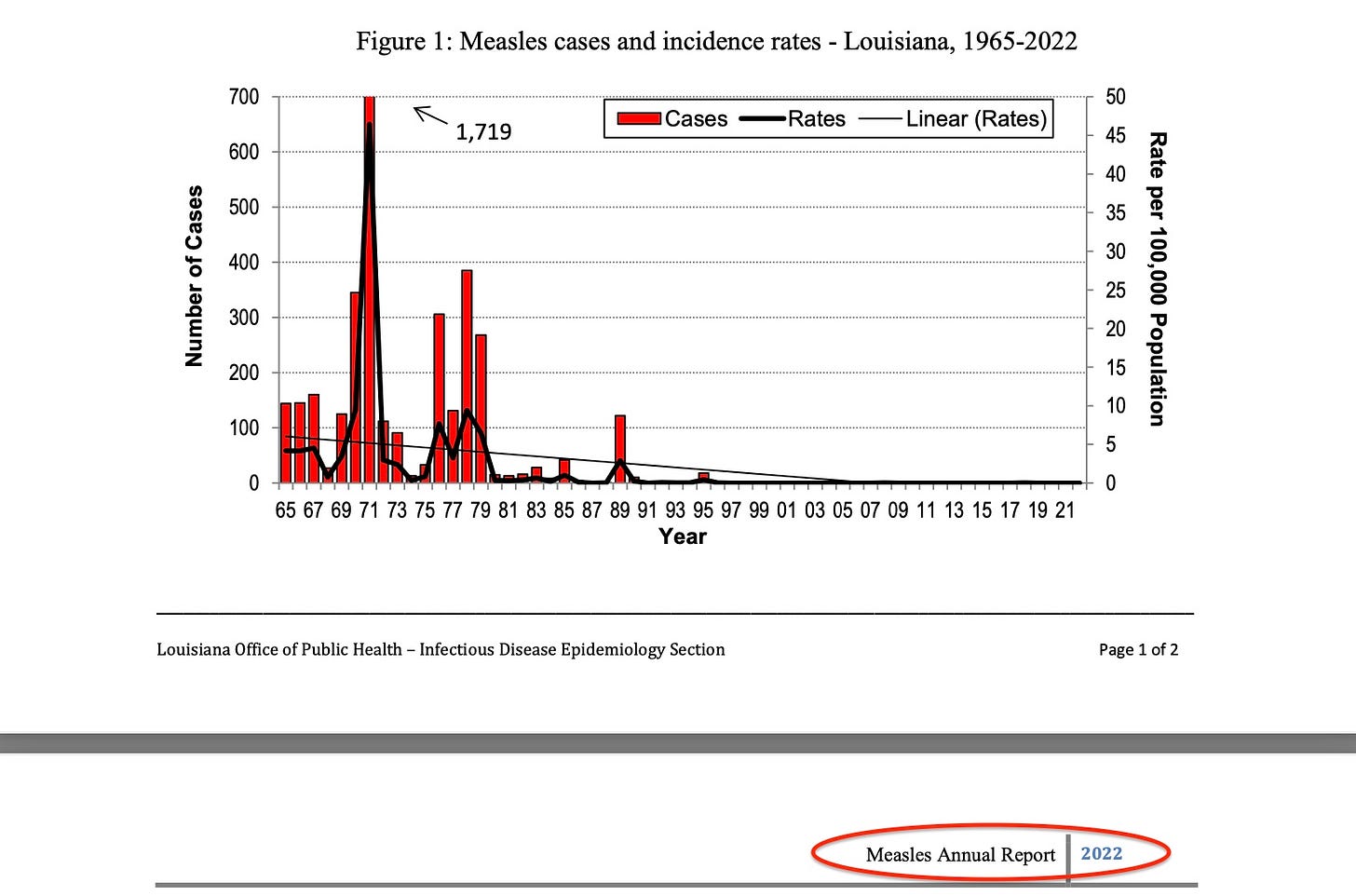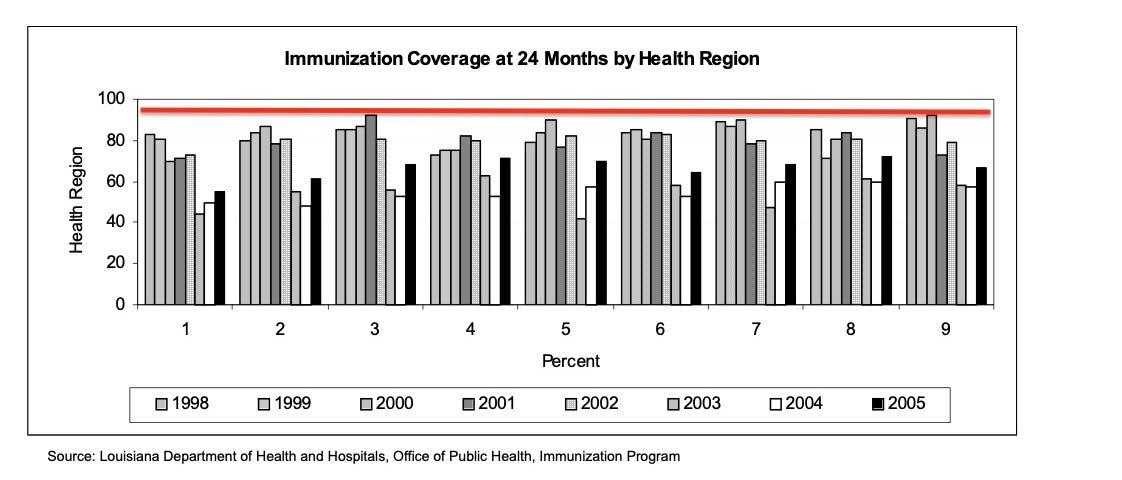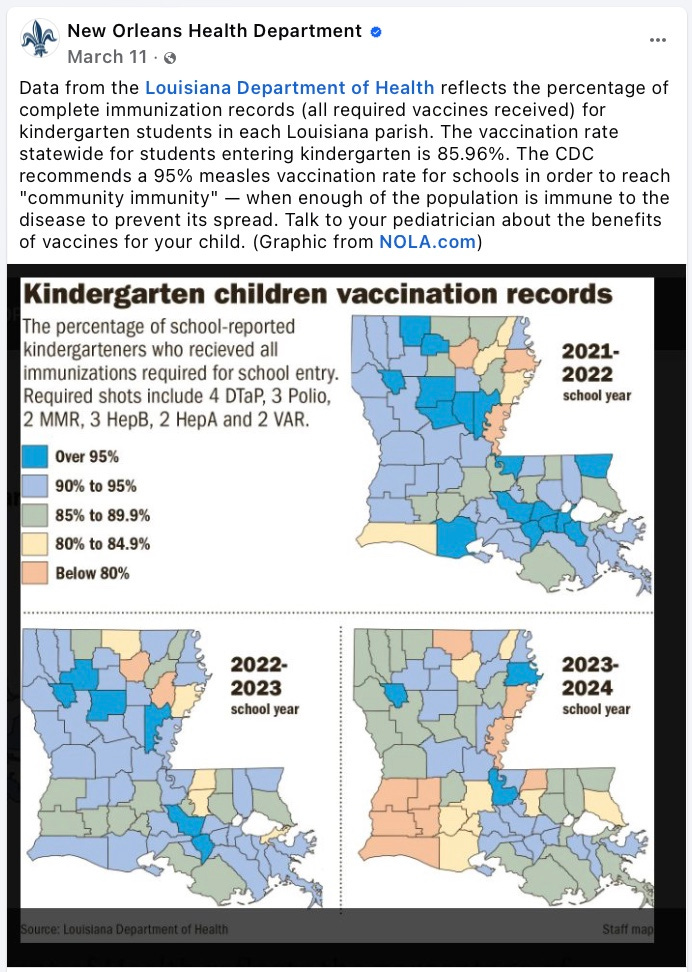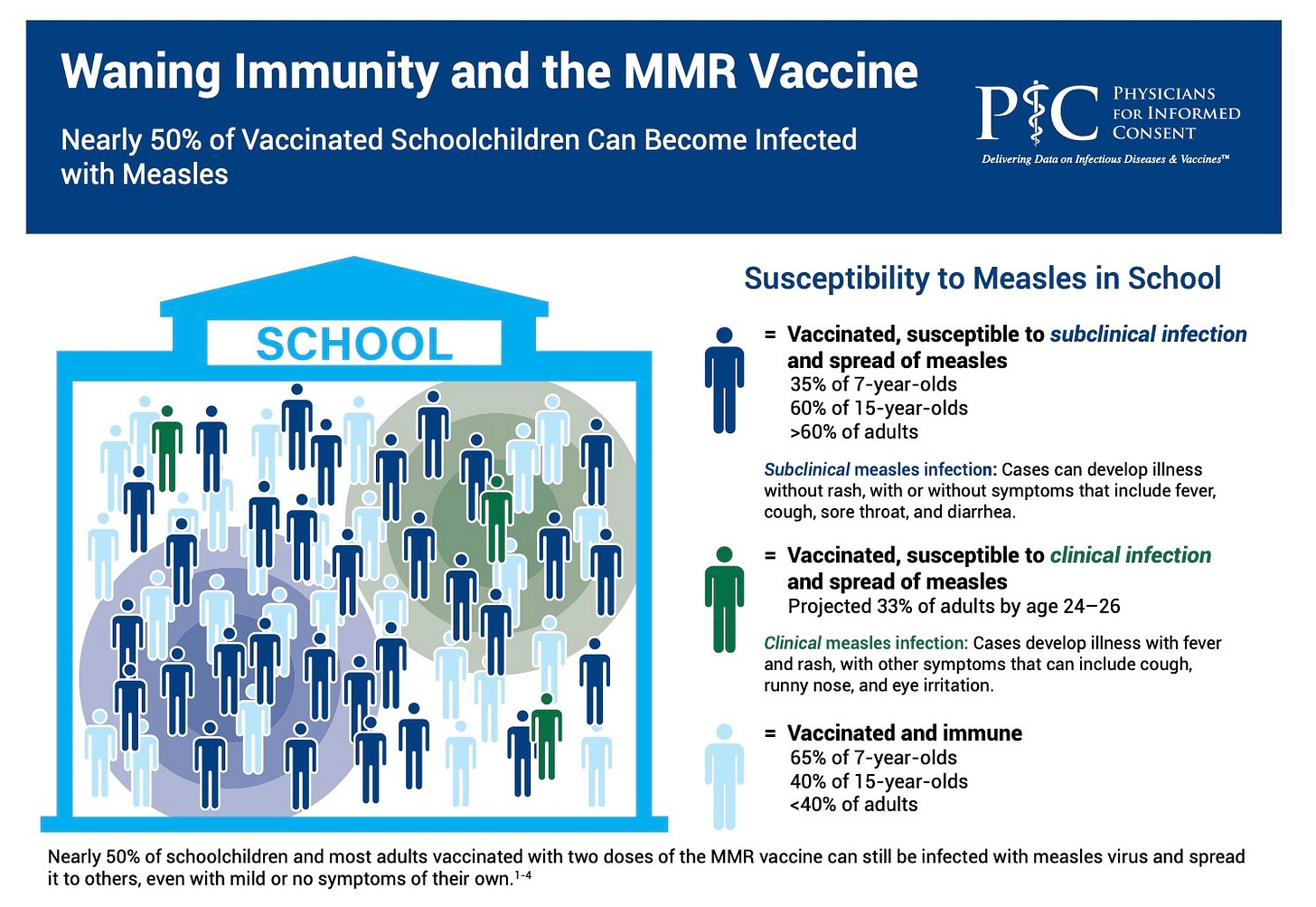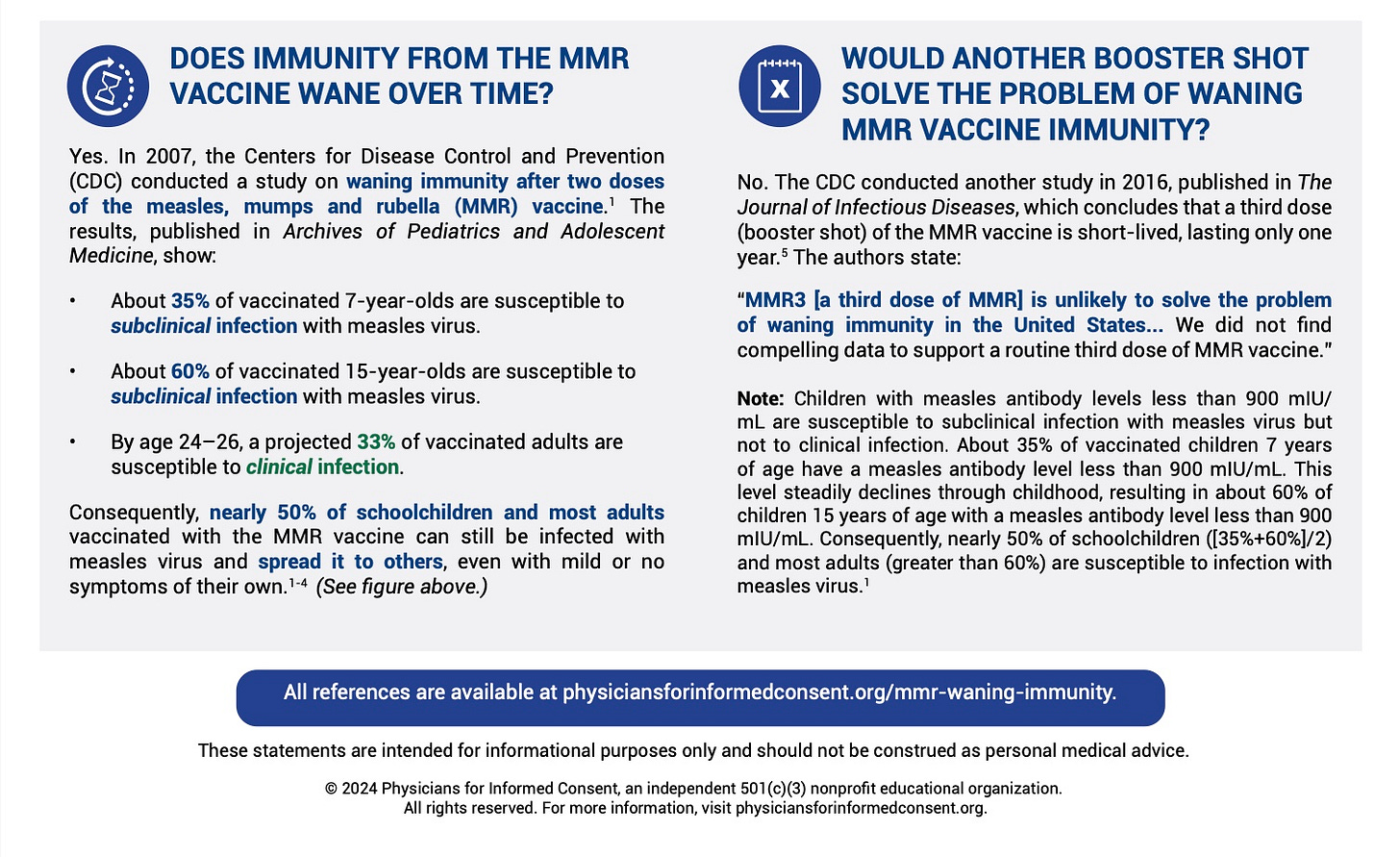No Measles Transmission for 28 Years—The Data Louisiana Can’t Ignore
Louisiana has remained free of circulating measles since 1996, despite lower-than-average vaccination coverage.
There has been no measles transmission in Louisiana since 1996.
It may come as a surprise, given the media hysteria over recent cases in Texas and beyond, that Louisiana has not experienced a single case of measles transmission in nearly thirty years. Of the six cases reported in Louisiana since 1996, all were travel-related—individuals exposed and infected outside Louisiana, who did not transmit measles to anyone inside the state. Of the three reported cases in Louisiana in 2024, two were infected in other states, and the third was exposed to measles outside the country. In 2018, two international travelers who were infected outside the U.S. arrived in Louisiana and were treated for measles. Another lone international traveler, infected with measles outside the U.S., arrived in Louisiana and was treated for measles in 2008.
The last reported case of measles transmission in Louisiana was in 1996, almost three decades ago.
Remarkably, during that same period, Louisiana’s vaccination rates among 2-year-olds—the age group eligible for the first MMR dose—have remained relatively low.
Since 1995, the state has released an annual Health Report Card, many of which are accessible online. Several editions provide a glimpse at vaccination rates among an eligible age group of either 2 or 3-year-olds. The earliest available online report from 2005 shows a wide variation in vaccination rates among 2-year-olds, with some as low as 23% in Calcasieu Parish.
As shown in the 2005 report, the bar graph, below, charts vaccination rates for each of the nine health regions, with the bar on the far left in each group representing data from 1995. Vaccinations in all regions dropped significantly in 2003, the white bar.
The 2006 Louisiana Health Report Card bar graph, below, is a tad bit easier to read but still indicates less than 95% vaccination rates in all nine health regions.
Also included in the 2006 report is a visual of statewide coverage rates by parish.
The 2010 Louisiana Health Report Card omits the usual bar graph and instead provides a state ranking and percentage vaccination coverage for children aged 19 to 35 months. Between 2006 and 2009, vaccination rates fluctuated significantly, ranging from around 70% to a peak of approximately 82%.
2010 marks the final year in the available online reports that includes any reference to immunization rates or coverage. From 1995 to 2010, vaccination rates for 2-3 year olds never reached 95% for the entire state. Not even close.
Despite historically low vaccination rates among eligible vaccine recipients, there have been no measles transmissions within our state’s border in almost thirty years.
This stands in stark contrast to a recent New Orleans Health Department (NOHD) social media post warning that lower kindergarten vaccination rates in Louisiana put “community immunity,” also known as herd immunity, at risk. The post specifically mentions that a 95% rate is needed to maintain it. The only difference between the two age groups—the 2-year-olds in the annual health report cards and kindergartners—is the required reporting of vaccination records for kindergarten attendance; otherwise, both groups spend time in communal settings, whether in daycare or school. Why would reduced vaccination rates in kindergartners be a threat when vaccination rates for 2 and 3-year-olds have been ridiculously low without a single case of measles transmission in the state in decades?
Ludicrously unaware, idiotic claims like this from NOHD are an example of WHY vaccination rates are falling. Parents no longer trust institutions like the NOHD, undoubtedly one of the worst offenders in Louisiana during covid. The City of New Orleans, with NOHD approval, enforced a covid vaccine passport and mandated covid shots for students as young as five in all 86 NOLA city schools—ending only when a 2024 law prohibited the practice.
The measles outbreak in Texas is like a bonanza for NOHD—they are pros at fearmongering and ethically incompetent at providing informed consent for vaccination.
Like all vaccine zealots, NOHD attempts to impose a moral imperative to vaccinate. They claim that vaccination is not just for you; it’s for the “community,” and vaccination will only work if a minimum of 95% of the community complies.
Herd Immunity is a concept we maintain applies solely to natural infection, not vaccination.
The MMR vaccine lacks the long-term efficacy needed to sustain herd immunity, a phenomenon more reliably established through natural infection with certain viruses like measles. Researchers acknowledge that 2-10% of MMR recipients will never seroconvert, so 95% vaccine “immunity” will never be achieved. Quite simply, the vaccine doesn’t work the same for everyone. And if it does “work,” it won’t last since vaccine “immunity” wanes.
“There are 2 major factors responsible for vaccine failures, the first is vaccine-related such as failures in vaccine attenuation, vaccination regimes or administration. The other is host-related, of which host genetics, immune status, age, health or nutritional status can be associated with primary or secondary vaccine failures. The first describes the inability to respond to primary vaccination, the latter is characterized by a loss of protection after initial effectiveness.”
“About 2–10% of healthy individuals fail to mount antibody levels to routine vaccines.”
The non-profit Physicians for Informed Consent provides a fantastic visual of Waning Immunity and the MMR Vaccine in the image below. In a fully vaccinated population, there will be varying degrees of vaccine effectiveness. Data indicates that an estimated 50% of vaccinated school-age children are susceptible to clinical measles infection, meaning they can become infected, will have symptoms, and are able to spread measles. In our view, the concern lies in the significant portion of the vaccinated population that remains susceptible to subclinical measles infection—meaning they can be infected and contagious without showing symptoms.
Is perpetual boosting the answer for waning MMR immunity?
By school age, children vaccinated according to the CDC’s recommended schedule will have received two doses of MMR, once around one year and then again at age 4. According to CDC data, a third dose of MMR does not provide sufficient protection:
“While a third MMR dose may successfully immunize the rare individual who did not respond after 2 doses, MMR3 is unlikely to solve the problem of waning immunity in the United States.”
Waning vaccine immunity is the reason why fully vaccinated populations like China, where they have no choice but to get vaccinated, continue to have outbreaks.
Additionally, as we shared in a previous article, the epidemiological shift created by the introduction of the MMR vaccine has left infants and the elderly more susceptible to measles infection. While attempting to mimic the benefits of natural infection, the MMR has upended the long-term stability of population-wide measles immunity.
The idea that low vaccination rates will trigger a measles outbreak in Louisiana doesn't hold up—the last thirty years say otherwise.
What’s more likely to drive future measles transmission is a faulty and ineffective vaccine.
During a MAHA press conference in Indiana on Tuesday, HHS Secretary Robert Kennedy acknowledged the issue, remarking, “the [MMR] vaccine wanes, the vaccines wane about 4.8% a year and so it’s a leaky vaccine, that problem will always be around.” Because the vaccine is faulty and has waning immunity, he stated, “We need to also make sure that doctors know how to treat measles…”
The most important takeaway from Sec. Kennedy today:
“Healthy children should not die of measles and there’s no reason they should, if the doctors know how to treat at the hospital, that will not happen.”
While Louisiana has not had measles transmission within our state border in almost thirty years, it is inevitable that it will happen one day. Measles isn’t going away—but naturally acquired immunity in older generations, along with any protection from vaccination, eventually will. Because a third dose of MMR is ineffective, we have to learn to live with measles and not be afraid of it.
Covid was a rude awakening for many parents who have no plans to vaccinate their children ever again. The lower vaccination statistics NOHD shares may reflect parents of fully vaccinated children who submitted a “written dissent” this year because they know the government should never have that information to begin with. There may be students who experienced vaccine injury, and their parents will no longer participate in the farce. There may be parents who research and discover that the MMR is made with and contains aborted fetal cell strains and so opt out of this one vaccine. And there may be parents who know and trust that a healthy and nourished immune system will function as intended with supportive care.
Whatever the parent chooses, our state and local health departments should respect those decisions and not use coercive messaging to change parents’ minds—like NOHD. If low vaccination rates lead to measles outbreaks, then Louisiana should have had an outbreak long ago.
If you value our work, please consider donating to support our efforts in protecting your rights and freedoms. We are 100% volunteer. We do not get paid and we do not pocket any of the money we receive; it all goes towards covering expenses. We give our time to research, inform, and empower others because we know it’s critical to maintaining our liberties. Parents must know their rights so they can protect their freedom.
Braving Freedom is a reader-supported publication. To receive new posts and support our work, please consider becoming a free or paid subscriber.





